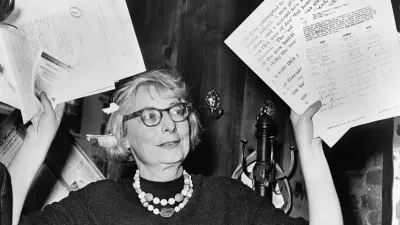The machine-city envisioned by Le Corbusier, and made into practice in decades of modernist bureaucracy, has ultimately produced, according to Simon Richards' essay, an antisocial environment, against which urban planning seems to be now reacting.
"Why is socializing in cities taken to be a good thing? Why do we assume it is beneficial for people to experience urban variety, opportunity, and intrigue? These are not questions normally asked, and it feels perverse to frame them as questions. Still, we have not always been so sure about socializing in cities. We have forgotten the negative argument - that the unregulated social life of large cities is a corrupting influence best avoided. It had never occurred to me to raise these questions until I began research on Le Corbusier. At the same time that he is celebrated as the visionary architect of such modernist masterpieces as the Villa Savoye (1928) and the pilgrimage chapel at Ronchamp (1955), he is decried as an irresponsible and perhaps mentally disturbed city planner. In his Plan Voisin from 1925, for example, Le Corbusier proposed to demolish the center of Paris and replace it with towers in parkland. The prospect of German cities bombed flat by the Allies during World War II made him envious - the Germans were able to rebuild from ground zero. (Incidentally, many British planners offered thanks to the Luftwaffe for returning the favor.) He made plans that would mean (as he put it himself) the "Death of the Street." In proposing the elimination of side alleys and shops, in granting limited space for cafés, community centers, and theaters, in dispersing them over great distances, and constructing them of uninviting concrete, glass, and steel, Le Corbusier expressed his contempt for the teeming hubbub that urbanists now esteem "
Thanks to Alessandro Busa'
FULL STORY: The Antisocial Urbanism of Le Corbusier

Planetizen Federal Action Tracker
A weekly monitor of how Trump’s orders and actions are impacting planners and planning in America.

Congressman Proposes Bill to Rename DC Metro “Trump Train”
The Make Autorail Great Again Act would withhold federal funding to the system until the Washington Metropolitan Area Transit Authority (WMATA), rebrands as the Washington Metropolitan Authority for Greater Access (WMAGA).

The Simple Legislative Tool Transforming Vacant Downtowns
In California, Michigan and Georgia, an easy win is bringing dollars — and delight — back to city centers.

Albuquerque’s Microtransit: A Planner’s Answer to Food Access Gaps
New microtransit vans in Albuquerque aim to close food access gaps by linking low-income areas to grocery stores, cutting travel times by 30 percent and offering planners a scalable model for equity-focused transit.

This City Will Pay You to Meet Your Neighbors
A North Kansas City grant program offers up to $400 for residents to throw neighborhood block parties.

Commentary: Our Silence Will Not Protect Us
Keeping our heads down and our language inoffensive is not the right response to the times we’re in. Solidarity and courage is.
Urban Design for Planners 1: Software Tools
This six-course series explores essential urban design concepts using open source software and equips planners with the tools they need to participate fully in the urban design process.
Planning for Universal Design
Learn the tools for implementing Universal Design in planning regulations.
Smith Gee Studio
City of Charlotte
City of Camden Redevelopment Agency
City of Astoria
Transportation Research & Education Center (TREC) at Portland State University
US High Speed Rail Association
City of Camden Redevelopment Agency
Municipality of Princeton (NJ)





























